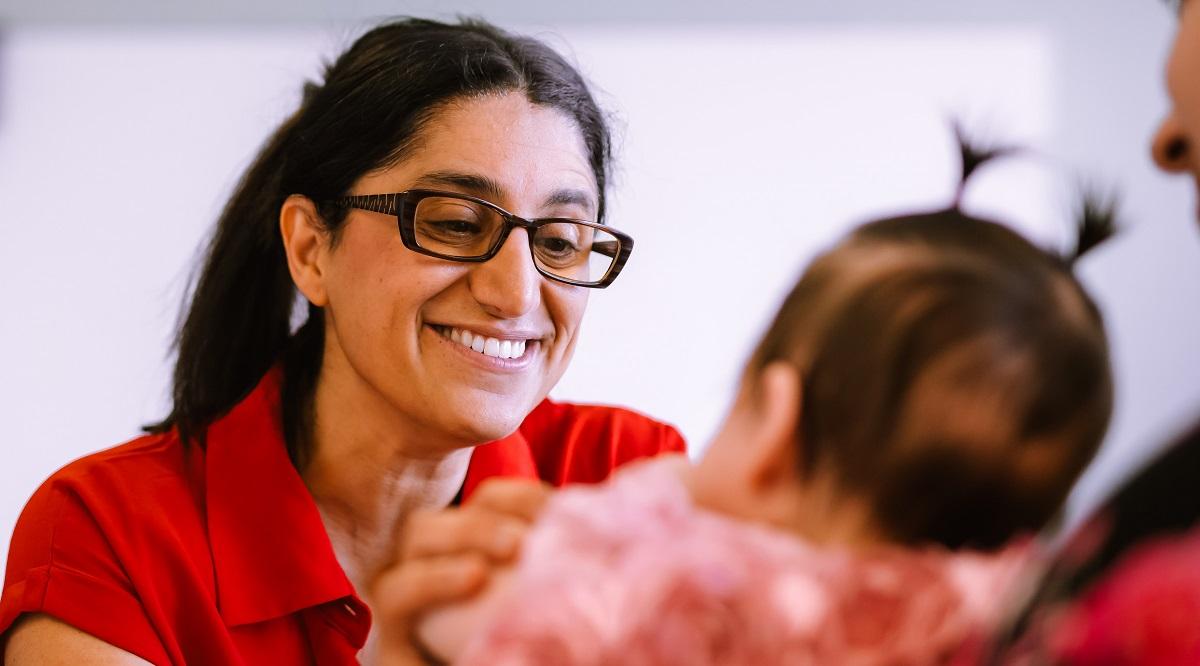In January 2024, the city of Flint, Michigan — notorious for its lead water crisis in 2014-2016 — implemented a new, and what some might consider unconventional, public health intervention: prescriptions for money.
The program, known as Rx Kids, gives pregnant people living in the city — one of the most economically disadvantaged cities in the United States — $1,500 during their pregnancy and an additional $500 a month for their child’s first year after birth. The payments are unconditional and don’t require recipients to verify income, hold a job, attend appointments, or fulfill any other obligations apart from filling out an application.
“The more I continue to practice, [I see that] so much of what ails our patients is not something I could prescribe away with something that pops up on electronic medical records,” says Mona Hanna-Attisha, MD, MPH, FAAP, a pediatrician, director of Rx Kids, and associate dean of Public Health at Michigan State University College of Human Medicine. She helped uncover the Flint water crisis and is now leading the rollout and effort to study the Rx Kids program. “I used to say I wish I could prescribe an antidote to poverty.”
Rx Kids is part of a wider trend of piloting and studying direct cash programs in the United States, following evidence gathered in low- and middle-income countries that showed success with similar programs aimed at improving health. Since 2020, nearly 150 mayors across the United States have implemented some kind of cash program in their cities, also known as guaranteed income. Additionally, some researchers at academic medical centers have launched clinical trials to study the impact of cash assistance for low-income patients on health outcomes, specifically for cancer patients and babies in the neonatal intensive care unit (NICU).
Researchers say that one of the benefits of the approach is that it allows people to use the money for whatever need is most pressing, whether that be taking time off work to spend with a new baby or using the funds to pay for safe housing or transportation to medical appointments. Additionally, unconditional cash programs have fewer administrative burdens and stigma that are generally associated with other assistance programs, such as the Supplemental Nutrition Assistance Program (SNAP) or Medicaid. But the programs also face barriers, including political opposition and a lack of research into how to most effectively implement them in the United States.
“That’s why this research is so important to quantify these benefits,” says Erika Hanson, JD, a clinical instructor at the Center for Health Law and Policy Innovation at Harvard Law School who has helped physician researchers in Boston navigate the legal side of direct cash clinical trials. “The goal is to avoid the more cataclysmic health outcomes in the long term.”
Success in low- and middle-income countries
Cash programs have become popular in countries across the globe, with more than 100 low- and middle-income countries implementing these types of programs over the past 20 years. They’ve become even more popular since the COVID-19 pandemic, when more than 600 new programs were introduced worldwide, according to a 2023 article in the scientific journal Nature. The article authors sought to add to the body of research looking at the economic impacts of cash programs by analyzing the effect of these programs on health and, after looking at data on 7 million people in 37 countries, found that cash grants were associated with a 20% reduction in mortality for women and an 8% reduction in mortality for children under 5 years old.
“When you look at the poverty literature, it tends to be focused on more economic-related outcomes,” says Aaron Richterman, MD, MPH, an assistant professor of Infectious Disease and Health Policy at the University of Pennsylvania Perelman School of Medicine in Philadelphia and lead author of the Nature article. He wanted to study how economic programs impact health so that policymakers can see the connection between poverty and poor health outcomes.
Richterman first became interested in studying anti-poverty programs when he was working at HIV and tuberculosis clinics in Haiti during his residency training in 2016-19.
In speaking with his patients, he learned that often the greatest barriers to good health were poverty related. For instance, despite near-miraculous advances in the medical treatment of HIV and free medication, Haitian HIV patients were still experiencing negative health outcomes due to other hardships like food or housing insecurity.
“[I saw the] ways these upstream factors can drive health outcomes,” Richterman says. “What do we do about that, if this is so central to why outcomes are the way they are?”
This question has been the crux of recent research in the United States, where political will, existing safety net programs, and living costs and conditions vary greatly from those in many of the countries previously studied.
In low-income countries, a relatively small amount of money can make a big difference for individuals and families. But in the United States, the threshold for the amount of money needed to make a difference for many people is much higher, making these programs more expensive, notes Brian Jacob, PhD, a professor of Public Policy, Economics, and Education at the University of Michigan. Jacob and a team of researchers conducted two direct cash studies in 2020 after the nonprofit organization GiveDirectly invited them to study their programs that provided one-time, unconditional payments of $1,000 to people who were eligible for federal SNAP benefits. The first study found some improvement in well-being for people who were very low-income (living on less than $500 a month), but the second study, conducted on a larger sample size, found no discernible impact of the cash on well-being.
“That really was the big, somewhat unsatisfying puzzle of the research,” Jacob says. “We would have expected to find some reduction in short-term material hardship. How can giving someone $1,000 — within a few weeks after — how can they not have less material hardship? That seems really hard to believe.”
The researchers explained that several factors could have confounded their results, including a limited number of survey respondents. They also noted that the period when the studies were conducted, during the spring and fall of 2020, was when there was an influx of federal aid that might have already boosted people’s financial situation independent of the cash grants.
“One possible explanation is, in the context of all of the other support that low-income families were receiving, the [extra $1,000] didn’t make as much difference as it would have during regular times,” Jacob says.
In the studies’ results, the researchers emphasize the need for further research to explore the effectiveness of direct cash programs and the best ways to implement them in the United States.
Alleviating the disease of poverty
On top of the hundreds of cash programs across the United States currently being tested, several academic medicine researchers are conducting clinical trials to study more specifically how unconditional cash assistance can impact health outcomes in particularly vulnerable patient populations.
At the University of Pennsylvania, Meredith Doherty, PhD, LCSW, is leading a randomized control trial to study the effect of cash assistance for cancer patients who are on Medicaid.
Doherty, who is an assistant professor of Social Work and Non-Profit Leadership and has practiced palliative care social work at safety-net hospitals, says she chose to focus on cancer patients both because cancer is one of the most costly diseases in the country and because, in her own work, she witnessed the extreme toll financial hardship took on cancer patients.
While overall cancer mortality rates have decreased by 30% over the last 30 years, people with low socioeconomic status and people of color continue to die from cancer at disproportionately high rates.
Data collected from a pilot trial revealed that cancer patients who received the cash assistance reported lower levels of anxiety and financial hardship, Doherty says. In the coming months and years, the researchers will study short- and long-term impacts on a number of metrics, including quality of life, adherence to treatment, and mortality.
Similarly, two physicians in Boston — Kira Bona, MD, an assistant professor of Pediatrics at Harvard Medical School and a pediatric oncologist at Dana-Farber Cancer Institute, and Margaret Parker, MD, MPH, a professor of Pediatrics at the University of Massachusetts Chan Medical School and a neonatologist — are conducting clinical trials studying the impact of unconditional cash assistance for the families of pediatric cancer patients and babies in the NICU.
A previous study led by Bona showed that pediatric cancer patients who come from low-income homes have worse outcomes than other patients receiving the same medical treatment. Other studies show that parents being present in the NICU with their babies has a positive effect on their development.
The cash program clinical trials will measure how unconditional cash payments impact the patients whose families receive money compared to the control groups whose families receive the current standard of care.
“Our current approaches to the problems these families are facing are falling short,” says Hanson, who co-authored the journal article on the clinical trials with Bona and Parker. “Existing programs, like Medicaid, SNAP, and rental assistance are really important for reducing poverty, but they don’t provide temporary, flexible funds when families are experiencing health complications.”
Doherty says that whenever she speaks with people in the medical profession about the promise of direct cash programs, the idea is met with enthusiasm, but there continue to be significant barriers to implementing the strategy widely.
The programs have garnered opposition in the political and legislative arenas in recent months. The attorney general of Texas is suing Harris County for its guaranteed income pilot program. Several states, including Iowa, Arkansas, and Idaho, have passed legislation banning cities and counties from offering unconditional cash aid, and politicians across the country have argued against them, saying they disincentivize people from working, NPR reports. Other studies suggest the programs don’t hurt productivity.
There are also administrative hurdles in many academic institutions to conducting studies using cash, Doherty says. Hanson adds that cash programs must be carefully designed to ensure that they don’t disqualify recipients from other social assistance programs.
Despite these barriers, Hanna-Attisha, who goes by Dr. Mona, is optimistic, in part because the United States has already demonstrated the effect that unconditional money can have on poverty rates. With the expanded federal assistance during the COVID-19 pandemic, including the expanded child tax credit, childhood poverty in the United States reached an all-time low, before rebounding after the COVID-19 relief was rolled back.
“It was devastating to be part of a society that actually cared for kids and finally used policy to provide for and take care of kiddos and to have that go away so quickly,” Hanna-Attisha says. “I felt that we needed something of a different scale to keep this work in the public imagination.”
That’s why she launched the Rx Kids program in Flint, which she hopes will be just the beginning of many more similar programs anchored by academic medical institutions. “Being an academic means we have this freedom to be creative and innovative and be able to really ask tough questions and come up with solutions for the betterment of the world,” Hanna-Attisha says. “That’s why I love being in academic medicine and being part of a university. That’s where Rx Kids was born; it was born out of academic medicine.”

